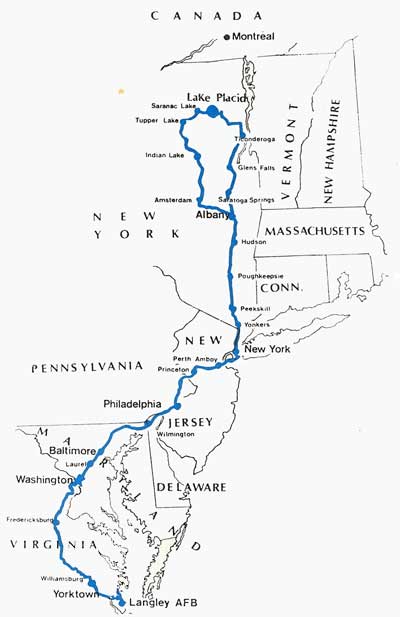1980 Olympic Torch Relay Route

The sacred Olympic Flame was lit on January 30, 1980 in Olympia,
Greece. the Flame was carried according to the tradition of the
Hellenic Olympic Committee to Athens for transfer ceremonies at
the Athens Olympic Stadium, and thereafter was transported in
miner's lamps aboard a U.S. aircraft to Langley Air Force Base,
Virginia. After formal welcoming ceremonies, the Flame began the
trip north to Lake Placid by runner.
The route was approximately 1600 kilometers long. The duration
of the relay was nine days.
The route divided in Albany, the capital of New York State.
From Albany, one torch traveled west through the central Adirondack
Mountains, and another torch traveled along the Lake Champlain
Valley before turning into the mountains. The two routes serve
to embrace the entire Adirondack region, uniting the whole area
in the Olympic spirit.
The two torches arrived in Lake Placid at the same time on
February 8, 1980. A welcoming ceremony was held at the time and
the flame was in repose in a place of honor until the Opening
Ceremony.
The Torch Relay Route served to carry the Olympic Flame through
some of the most historic places in America.
Highlights:
COUPERTIN GROVE: The first Greek runner pauses at the monument
to Pierre de Coubertin at Olympia, to salute and honor the founder
of the modern Olympic Games, and first president of the International
Olympic Committee.
OLYMPIC STADIUM: For the first time in the history of the
Winter Games, a Greek runner will enter the Olympic Stadium in
Athens, and transfer the flame to the Lake Placid Olympic Organizing
Committee. For previous Winter Games, this was done at Athens
Airport.
ACROSS THE ATLANTIC: The flame was placed aboard a United
States aircraft at the Athens Airport for the trip to Langley
Air Force Base in Virginia.
LANGLEY A.F.B.: the flame landed at dawn at Langley Air Force
Base for a brief ceremony.
YORK RIVER: The flame is transferred aboard a naval surface
craft for the 21-mile trip up the York river to the Yorktown Post
Office Dock, symbolizing the arrival by sea of America's original
settlers.
YORKTOWN: American Torch Relay began in Yorktown, the site
of Washington's final victory of the American Revolution. (Yorktown
is directly across the peninsula from Jamestown, the site of the
first English-speaking settlement in America.)
HANOVER, VIRGINIA: Relay followed country route via historical
Washington-Rochambeau Victory Route as far as Hanover, Virginia,
passing through Colonial Williamsburg.
MT. VERNON, VIRGINIA: A brief dawn ceremony at the home and
grave of George Washington, first president of the United States.
WASHINGTON, D.C.: The relay was run throughout the night.
It entered the nation's capital via the Memorial Bridge, circled
the Lincoln Memorial, passed by the White House, followed Pennsylvania
Avenue to the Capitol for the national welcoming ceremonies.
BALTIMORE, MARYLAND: Relay continued to Baltimore where first
overnight stop was made. Flame rested overnight at Washington
Monument.
INDEPENDENCE HALL: Major ceremony is held in Philadelphia,
Pennsylvania at Independence Hall.
NEW YORK CITY: a major ceremony took place at City Hall in
the nation's economic and cultural capital.
HYDE PARK, NEW YORK: The relay paid homage at the home and
grave of Franklin D. Roosevelt, 32nd president of the United States,
who opened the III Olympic Winter Games at Lake Placid 1932.
ALBANY, NEW YORK: new York State welcoming ceremony was held
at the Nelson Rockefeller Empire State Plaza, in Albany, the capital
of New York State.
LAKE PLACID, NEW YORK: Two runners, each with a separate torch,
arrived fro two directions in Lake Placid at the same time (7:30
P. M., February 8, 1980.)
Additional Facts
OVERNIGHT STOPS: Baltimore, MD.; Wilmington, Del.: Princeton,
NJ; Peekskill, Hudson, Saratoga Springs, Amsterdam, Ticonderoga
and Indian Lake, New York.

